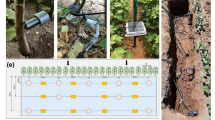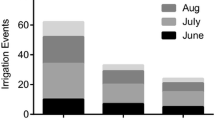Abstract
The usefulness of continuous measurement of soil and plant water status for automated irrigation scheduling was studied in a drip-irrigation experiment on plum (Prunus salicina Black Gold). Two levels of water restriction were imposed at different phenological periods (from pit-hardening to harvest, post-harvest) and compared with a well irrigated control treatment. Soil matrix water potential (ψ soil) was measured with granular matrix sensors (Watermark); and short-period trunk diameter variation (TDV) was measured with linear variable displacement transformers. The Watermark sensor readings were in reasonable agreement with the irrigation regime and showed a good indication of plant water status across the season (r 2=0.62), although they were a better predictor of stem water potential (ψ stem) in the dry range of ψ soil. Nonetheless, the most important drawback in their use was the high variability of readings (typical CV of 35–50%). From TDV measurements, maximum daily shrinkage (MDS) and trunk growth rate (TGR) were calculated. Their performance was also compared with ψ stem, which had the lowest variability (CV of 7%). During most of the fruit growth period, when TGR was minimum, MDS was higher in the less-irrigated treatment than in the control and correlated well (r 2=0.89) with ψ stem. However, after harvest, when TGR was higher, this correlation decreased as the season progressed (r 2=0.73–0.52), as did the slope between MDS and ψ stem, suggesting tissue elasticity changes. Later in the season, TGR was better related to plant water status. These observations indicate some of the difficulties in obtaining reference values useful for irrigation scheduling based exclusively on plant water status measurements.






Similar content being viewed by others
References
Allen R (2000) Calibration for the Watermark 200SS soil water potential sensor to fit the 7-19-96 “calibration°3” table from Irrometer. University of Idaho, Kimberley
Cohen M, Goldhamer DA, Fereres E, Girona J, Mata M (2001) Assessment of peach tree responses to irrigation water deficits by continuous monitoring of trunk diameter changes. J Hortic Sci Biotechnol 76:55–60
Doorenbos J, Pruit WO (1977) Crop water requirements. (Irrigation and drainage, paper 24) FAO, Rome
Egbert JA, Baker S, Baker JM (1992) Calibration of Watermark soil moisture sensors for soil matrix potential and temperature. Plant Soil 143:213–217
Eldredge EP, Schock CC, Stieber T (1993) Calibration of granular matrix sensors for irrigation management. Agron J 85:1228–1232
Fereres E, Goldhamer DA (1990) Deciduous fruit and nut trees. In: Stewart BA, Nielsen DR (eds) Irrigation of agricultural crops. ASA, Madison, Wis., pp 987–1017
Fereres E, Goldhamer DA (2003) Suitability of stem diameter variations and water potential as indicators for irrigation scheduling of almond trees. J Hortic Sci Biotechnol 78:139–144
Flore JA, Layne DR (1997) Prunus. In: Zamski E, Schaffer AA (eds) Photoassimilate distribution in plants and crops: sink–source relationship. Dekker, New York
Genard M, Fishman S, Vecambre G, Huguet JC, Bussi C, Besset J, Habib R (2001) A biophysical analysis of stem and root diameter variations in woody plants. Plant Physiol 126:188–202
Goldhamer DA, Fereres E (2001) Irrigation scheduling protocols using continuously recorded trunk diameter measurements. Irrig Sci 20:115–125
Goldhamer DA, Fereres E, Mata M, Girona J, Cohen M (1999) Sensitivity of continuous and discrete plant and soil water status monitoring in peach trees subjected to deficit irrigation. J Am Soc Hortic Sci 1244:437–444
Grossman YL, DeJong TM (1994) PEACH: a simulation model of reproductive and vegetative growth in peach trees. Tree Physiol 14:329–345
Hanson RB, Orloff S, Peters D (2000a) Monitoring soil moisture helps refine irrigation management. Calif Agric 54:38–42
Hanson RB, Orloff S, Peters D (2000b) Effectiveness of tensiometers and electrical resistance sensors varies with soil condition. Calif Agric 54:47–50
Hendrickx JMH, Wierenga PJ (1990) Variability of soil water tension in a trickle irrigated Chile pepper field. Irrig Sci 11:23–30
Huguet JG, Li SH, Lorendeau JY, Pelloux G (1992) Specific micromorphometric reactions of fruit trees to water stress and irrigation scheduling automation. J Hortic Sci 67:631–640
Irmak S, Haman DZ (2001) Performance of the Watermark granular matrix sensor in sandy soils. Appl Eng Agric 17:787–795
Johnson RS, Handley DF, Day KR (1994) Postharvest water stress of an early maturing plum. J Hortic Sci 69:1035–41
Kozlowski TT, Pallardy SG (2002) Acclimation and adaptive response of woody plants to environmental stresses. Bot Rev 68:270–334
Larson GF (1985) Electrical sensor for measuring moisture in landscape and agricultural soils. U.S. Patent 4531087
Leib BG, Jabro JD, Mathews GR (2003) Field evaluation and performance comparison of soil moisture sensors. Soil Sci 168:396-408
Marsal J, Gelly M, Mata M, Arbonés J, Rufat J, Girona J (2002) Phenology and drought affects the relationship between daily trunk shrinkage and midday stem water potential of peach trees. J Hortic Sci Biotechnol 77:411–417
McCann IR, Kincaid DC, Wang D (1992) Operational characteristics of the watermark model 200 soil water potential sensor for irrigation management. Appl Eng Agric 8:603–609
Moriana A, Fereres E (2002) Plant indicators for scheduling irrigation of young olive trees. Irrig Sci 21:83–90
Sellés G, Berger A (1990) Physiological indicators of plant water status as criteria for irrigation scheduling. Acta Hortic 278:87–99
Shock CC, Feibert EBG, Saunders LD (1998a) Potato yield and quality response to deficit irrigation. HortScience 33:655–659
Shock CC, Feibert EBG, Saunders LD (1998b) Onion yield and quality affected by soil water potential as irrigation threshold. HortScience 33:1188–1191
Taber HG, Lawson V, Smith B, Shogren D (2002) Scheduling microirrigation with tensiometers or Watermarks. Int Water Irrig 22:22–26
Turner NC (1981) Techniques and experimental approaches for the measurement of plant water status. Plant Soil 58:339–366
Tyree MT, Jarvis PG (1982) Water relations and carbon assimilation. In: Lange OL, Nobel PS, Osmond CB, Ziegler H (eds) Physiological plant ecology II. Springer, Berlin Heidelberg New York, pp 35–78
Acknowledgements
This research was supported by funds from CICYT, project AGL2000-0387-C05-03. Thanks are also due to personnel from the STR for the meteorological data, to B. Tamargo and field personnel from “Cooperativa de Llíria” for help in orchard irrigation and management and to Dr. E. Carbonell and J. Pérez for statistical analysis of data. The critical reading of Dr. Carlos Ramos is gratefully acknowledged.
Author information
Authors and Affiliations
Corresponding author
Additional information
Communicated by J. Ayars
Rights and permissions
About this article
Cite this article
Intrigliolo, D.S., Castel, J.R. Continuous measurement of plant and soil water status for irrigation scheduling in plum. Irrig Sci 23, 93–102 (2004). https://doi.org/10.1007/s00271-004-0097-7
Received:
Accepted:
Published:
Issue Date:
DOI: https://doi.org/10.1007/s00271-004-0097-7




